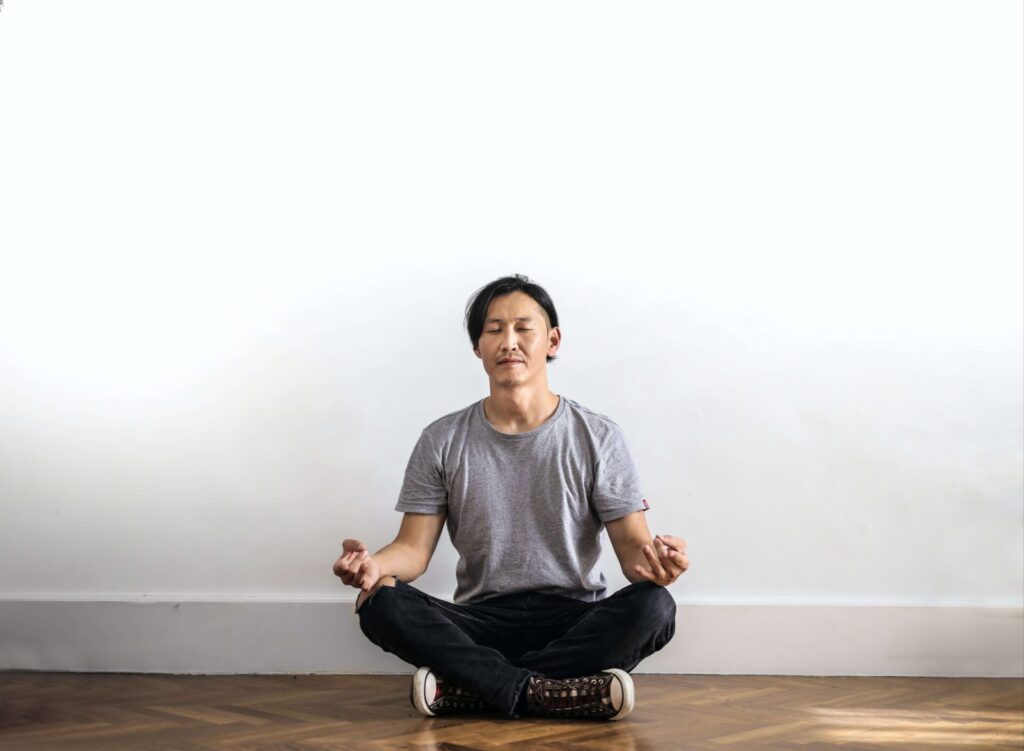Introduction
There are many people interested in any type of meditation for different reasons. The sheer number of Buddhists visiting various temples and monasteries in Myanmar, Sri Lanka and Thailand to learn meditation is evidence of that. Furthermore, there are guided meditation apps with millions of users.
However, not many people know how to approach meditation as a regular practice and not many teachers teach that. Most meditation teachers are focused on teaching the methods yet many beginner meditators need more than that. This is because regular meditation practice not only requires knowledge, the most important aspect is the mindset. This article will point out commonly wrong mindsets about meditation and offer the right ones so that meditators can attain peace of mind and spiritual gains through long term regular practice.
Causes of wrong mindset

Uncontrolled initial enthusiasm
It is natural for people to experience higher than normal enthusiasm when embarking on new endeavours. The enthusiasm will be even higher if these new endeavours help with the problems encountered in the present.
Many researches have been done on the potential benefits of meditation practice especially after its propagation in the western societies. These potential benefits include mental alertness, reducing stress, better self-control, better sleep quality and many others1. With these information widely available on the internet, they fuel the enthusiasm that beginners experience to a very high level. As such, the effort and time put into meditation may put experienced meditators to shame.
However, these beginning meditators do not realise that meditation is akin to exercise: As a person cannot build muscles overnight, a person also cannot experience the benefits of meditation overnight. Short term bursts of exercising and meditation may give benefits, albeit short-lived, because the person started from zero so any increment at the start is much easier than increments at a higher level. On the other hand, a beginner putting in too much effort will cause injuries more easily due to putting too much stress on the unconditioned body and mind and using the wrong methods.
Unrealistic expectations
This cause is linked the one above. Due to experiencing the starting benefits of meditation, people get unrealistic expectations of meditation. They feel that they may be “gifted” in meditation and so want to attain a high level of mindfulness and concentration in a short amount of time.
However, as one’s meditation practice start to improve, benefits of meditation start to have diminishing returns until one reaches a plateau. Together with overexerting and wrong meditation methods, it is almost guaranteed that the unrealistic expectations will not be met.
Discomforts
People often have misconceptions about the benefits of meditation. They are led to believe that meditation can cure all types of ailments, both mental and physical. These “miracle” benefits of meditation are often propagated by teachers who want to attract more people to join their classes. This results in many people using meditation to try to heal their ailments instead of seeking proper medical help.
A neuroscientist commented that although there are some research findings suggesting that meditation is beneficial to ailments like depression, chronic pain and anxiety, the effects are at best on par with existing treatments2. Therefore, it is important to know the limitations of meditation and not have the blind faith that it is a cure-all “miracle pill”.
Meditation location
The most frequent excuse for not meditating regularly is that the home is not conducive for meditation as it has too many distractions. People want to go to temples, monasteries and even abroad to get in a few days of meditation practice. Hence, they will always postpone their meditation practice to wait for the opportunity to go to the “right” places to meditate. This often ends up with them not doing any meditation practice at all for long periods of time because they are too busy to visit these “right” places for meditation.
There are also volunteers who find that they are unable to meditate in temples and monasteries because they have duties there and their meditation practice is frequently disrupted by calls to render help. This goes to show that the place is not the problem; it is the person’s reactions to these “disturbances” that is the real problem.
Effects of wrong mindset

Disheartenment and Burnout
Coupling uncontrolled initial enthusiasm and unrealistic expectations, it is very easy for beginning meditators to put in too much effort in a short time but the returns (benefits) do not match up to their expectations. When such a situation arises, these people can get disheartened and think that meditation is not working as advertised for them.
Another possible scenario for these people is that they put in even more effort thinking that they have not done enough. However, the brain and body cannot keep up with such an intensive practice and slowly start to breakdown. Furthermore, meditation benefits start to dwindle due to overexertion and only sheer willpower is keeping them going. Under such circumstances, sooner or later, burnout will occur. The intensity of the burnout depends on how much overexertion was applied. The higher the overexertion, the worse the burnout. In serious cases, burnout can cause a person to give up meditation for the rest of the person’s life and may even develop a deep hatred for it.
Phobia
When people try to use meditation to treat all types of ailments, phobia towards meditation can occur due to too much mental and/or body discomforts. It will become scary to continue meditating if the discomforts exceed the person’s endurance threshold. When the threshold is crossed, the mind simply chooses to give up and will reject the idea of any more meditation due to the fear of impending discomforts.
Phobias can be very difficult to get rid once it grabs hold of a person. Even when offered remedies with proven track records, the person may still be persistently reluctant to try meditation again.
Sporadic meditation
As mentioned in “Meditation location”, there are people who look for the “right” place to meditate instead of trying to make some changes so that their homes are conducive to meditation. Change is always difficult so without determination and effort, nothing will change at home. The same can be said for volunteers with duties in temples and monasteries.
For other causes mentioned above that are not serious enough to make a person stop meditating permanently, the most common outcome is sporadic meditation practice. Sporadic meditation practice is a vicious cycle because the person will never truly experience the full benefits of long-term meditation and due to that, will never put in enough time and effort to establish regular practice. The cycle goes on spiralling downwards until the complete halt of meditation practice.
Therefore, although sporadic meditation practice is an effect not as serious as burnouts or phobias but the end result is the same: Giving up on meditation practice. The only difference is that it takes a longer time to see the end result.
Mindset for long-term meditation

Slow and easy wins the race
Meditation is not a competition whereby only the first one to reach the goal wins. Instead, it has a goal that is attainable by anyone who spends enough time and effort to master it. Studies have shown that regular, long-term meditation practice instead of irregular, short bursts of practice are more beneficial3. Therefore, an important step to establish long-term meditation practice is to curb the enthusiasm and expectations so as not let them balloon out of control. Set a schedule to meditate at the same time and for the same duration every day.
This is the same as cultivating a good habit for yourself which takes at least 2 months to 8 months to form, depending on individuals and their circumstances4. Therefore, be patient and tenacious. Try to stick to your meditation schedule as strictly as you can and for as long as you can in order to make it a long-lasting habit.
Seek professional help for your ailments
Getting proper treatment for ailments will reduce the discomforts during meditation, thus reducing the chance of developing phobia towards meditation. This may seem like an obvious thing to do when a person is ill, whether physically or mentally, but many people do not do so for many different reasons. Instead, they like to depend on “recommendations” or simply let it be until it is too late.
The important thing to note here is that meditation is not a cure-all “miracle pill”. Even if it helps with a certain ailment for one person, it does not mean that it can help another person with the same ailment as the severity of the ailment may be different. Also, everyone is different and has developed ailments from different circumstances so it is best to seek professional help. Furthermore, not seeking professional help may end disastrously when a person realises that meditation does not help. This is because it will take a long time for such a realisation to dawn and by then, the condition may have deteriorated to a worse state and the ailment becomes incurable even with proper treatment.
How meditation can help is as an assistance to formal treatments. For example, a person with serious depression should only try meditation after professional help is sought to improve and stabilise the condition instead of diving straight into meditation and getting advice from meditation teachers who do not have any training in psychology treatment. They may be able to give advice to people with a healthy mind but a mind with an ailment is another matter altogether. This is the same as a teacher being capable in teaching normal students but is unable to teach students with special needs as it requires another set of skills and expertise that is beyond this teacher. Another example is for a person with back ailments to consult physiotherapists to relieve the aches and pains. Then, instead of sitting cross-legged on the floor, this person may use a chair that provides lumbar support for the meditation practice. This will prevent overstressing the back and the meditation practice can be done regularly.
Meditation is also good as a preventive measure for many mental ailments like stress, depression and even old age cognitive decline5. However, this will only work if meditation is practiced over the long-term.
Make changes to the environment
There are a few steps to make the environment conducive for meditation:
1) Set up a small space for meditation
This is important because you need a place that the mind and body can associate with meditation. This is the same as the mind and body associating temples and monasteries with meditation.
The space does not have to be big: Enough space for you to sit comfortably whether on the floor or a stool. It can be covered up by a curtain or a room divider. If you want, you can place a small Buddha statue or image in this space.
2) Inform your family members of your meditation schedule
The key point to note here is communication. If you are frquently disrupted during meditation by family members, that is because you have not communicated your meditation schedule with them. Therefore, informing them beforehand and pasting your schedule somewhere visible can help to minimise the disturbances. This may not work immediately but if persistently done, they will realise your strong desire to do meditation practice and they will cooperate with you.
Additionally, you can get them to help you with chores during this time so that you can enjoy your meditation time without any worries. The same goes for volunteers who like to meditate at temples and monasteries. Let the staff know that you want to meditate for a specified amount of time and that you will attend to matters after that.
3) Download a meditation app that puts the phone in airplane mode
It is especially important to download an app that will serve 3 purposes: Time your sittings, keep a record and prevent notifications from disrupting your practice. Many free meditation apps have these 3 functions, so use the one that you like to help maintain consistent practice.
4) Use a notebook and pen
Sometimes, old-fashioned ways work better than new technological methods. The purpose of the notebook and pen is for you to take note of thoughts that do not go away no matter what you do. For example, you have this nagging thought to do the laundry after meditation and it will not go away no matter what you do. At this time, open your notebook and take note of it. You will find that after doing this, your mind will be able to let it go and you can meditate in peace.
The reason why you do not want to use your phone as a recording device is because there are too many distractions in the phone. The moment you switch from the meditation app to the note-taking app, you may see unread messages popping up, then you will be busy answering messages instead of meditating. Even if you do go back to meditation after answering the messages, you will find it difficult to bring the focus back on the meditation object.
Conclusion

Whether you are a beginning meditator or having meditated for many years, one of the reasons for not progressing can be attributed to having the wrong meditation mindset. If you find that you fit one of the causes mentioned above, make a determined effort to change your mindset and you will find your meditation progress more smoothly. Remember that making mistakes is not the problem; it is realising your mistake yet not doing anything to remedy it that makes it the biggest problem.
References
- 12 Science-Based Benefits of Meditation
- When science meets mindfulness
- How Long Should You Meditate to Get the Benefits? Here’s What the Science Says
- How Long Does it Actually Take to Form a New Habit? (Backed by Science)
- Could Meditation Help Prevent Cognitive Decline in Adults with MCI or Early Alzheimer’s?
